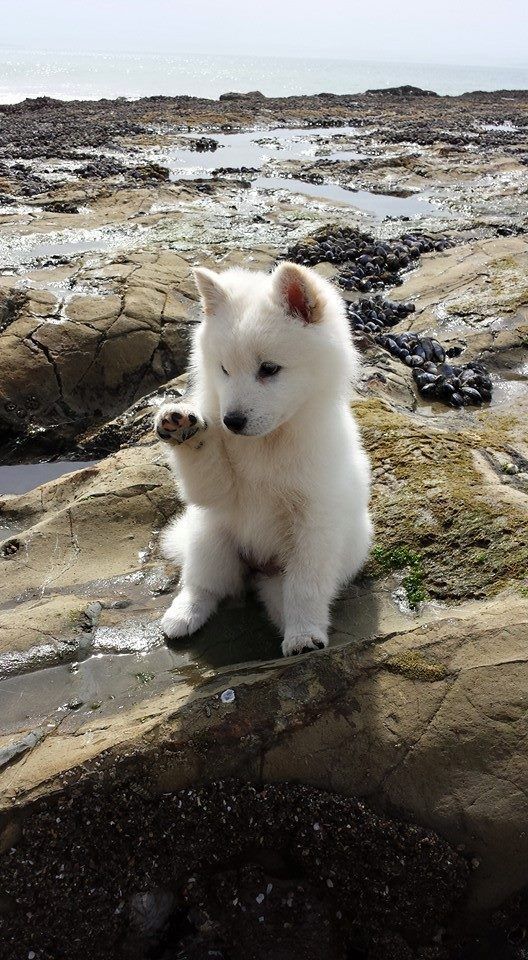You Know What The Mexicans Say About The Pacific? They Say It Has No Memory. That’s Where I Want To





You know what the Mexicans say about the Pacific? They say it has no memory. That’s where I want to live the rest of my life. A warm place with no memory. Open up a little hotel right on the beach. Buy some worthless old boat and fix it up new. Take my guests out charter fishing. Zihuatanejo. In a place like that, I could use a man that knows how to get things.
The Shawshank Redemption (1994) dir. Frank Darabont
More Posts from Ocrim1967 and Others
NASA’s New Planet Hunter Reveals a Sky Full of Stars

NASA’s newest planet-hunting satellite — the Transiting Exoplanet Survey Satellite, or TESS for short — has just released its first science image using all of its cameras to capture a huge swath of the sky! TESS is NASA’s next step in the search for planets outside our solar system, called exoplanets.

This spectacular image, the first released using all four of TESS’ cameras, shows the satellite’s full field of view. It captures parts of a dozen constellations, from Capricornus (the Sea Goat) to Pictor (the Painter’s Easel) — though it might be hard to find familiar constellations among all these stars! The image even includes the Large and Small Magellanic Clouds, our galaxy’s two largest companion galaxies.
The science community calls this image “first light,” but don’t let that fool you — TESS has been seeing light since it launched in April. A first light image like this is released to show off the first science-quality image taken after a mission starts collecting science data, highlighting a spacecraft’s capabilities.

TESS has been busy since it launched from NASA’s Kennedy Space Center in Cape Canaveral, Florida. First TESS needed to get into position, which required a push from the Moon. After nearly a month in space, the satellite passed about 5,000 miles from the Moon, whose gravity gave it the boost it needed to get into a special orbit that will keep it stable and maximize its view of the sky.

During those first few weeks, we also got a sneak peek of the sky through one of TESS’s four cameras. This test image captured over 200,000 stars in just two seconds! The spacecraft was pointed toward the constellation Centaurus when it snapped this picture. The bright star Beta Centauri is visible at the lower left edge, and the edge of the Coalsack Nebula is in the right upper corner.

After settling into orbit, scientists ran a number of checks on TESS, including testing its ability to collect a set of stable images over a prolonged period of time. TESS not only proved its ability to perform this task, it also got a surprise! A comet named C/2018 N1 passed through TESS’s cameras for about 17 hours in July.
The images show a treasure trove of cosmic curiosities. There are some stars whose brightness changes over time and asteroids visible as small moving white dots. You can even see an arc of stray light from Mars, which is located outside the image, moving across the screen.

Now that TESS has settled into orbit and has been thoroughly tested, it’s digging into its main mission of finding planets around other stars. How will it spot something as tiny and faint as a planet trillions of miles away? The trick is to look at the star!
So far, most of the exoplanets we’ve found were detected by looking for tiny dips in the brightness of their host stars. These dips are caused by the planet passing between us and its star – an event called a transit. Over its first two years, TESS will stare at 200,000 of the nearest and brightest stars in the sky to look for transits to identify stars with planets.

TESS will be building on the legacy of NASA’s Kepler spacecraft, which also used transits to find exoplanets. TESS’s target stars are about 10 times closer than Kepler’s, so they’ll tend to be brighter. Because they’re closer and brighter, TESS’s target stars will be ideal candidates for follow-up studies with current and future observatories.

TESS is challenging over 200,000 of our stellar neighbors to a staring contest! Who knows what new amazing planets we’ll find?
The TESS mission is led by MIT and came together with the help of many different partners. You can keep up with the latest from the TESS mission by following mission updates.
Make sure to follow us on Tumblr for your regular dose of space: http://nasa.tumblr.com.
I love the sky colors ☀️ 🌤❤️
















Using All of Our Senses in Space
Today, we and the National Science Foundation (NSF) announced the detection of light and a high-energy cosmic particle that both came from near a black hole billions of trillions of miles from Earth. This discovery is a big step forward in the field of multimessenger astronomy.
But wait — what is multimessenger astronomy? And why is it a big deal?
People learn about different objects through their senses: sight, touch, taste, hearing and smell. Similarly, multimessenger astronomy allows us to study the same astronomical object or event through a variety of “messengers,” which include light of all wavelengths, cosmic ray particles, gravitational waves, and neutrinos — speedy tiny particles that weigh almost nothing and rarely interact with anything. By receiving and combining different pieces of information from these different messengers, we can learn much more about these objects and events than we would from just one.

Lights, Detector, Action!
Much of what we know about the universe comes just from different wavelengths of light. We study the rotations of galaxies through radio waves and visible light, investigate the eating habits of black holes through X-rays and gamma rays, and peer into dusty star-forming regions through infrared light.

The Fermi Gamma-ray Space Telescope, which recently turned 10, studies the universe by detecting gamma rays — the highest-energy form of light. This allows us to investigate some of the most extreme objects in the universe.

Last fall, Fermi was involved in another multimessenger finding — the very first detection of light and gravitational waves from the same source, two merging neutron stars. In that instance, light and gravitational waves were the messengers that gave us a better understanding of the neutron stars and their explosive merger into a black hole.

Fermi has also advanced our understanding of blazars, which are galaxies with supermassive black holes at their centers. Black holes are famous for drawing material into them. But with blazars, some material near the black hole shoots outward in a pair of fast-moving jets. With blazars, one of those jets points directly at us!
Multimessenger Astronomy is Cool

Today’s announcement combines another pair of messengers. The IceCube Neutrino Observatory lies a mile under the ice in Antarctica and uses the ice itself to detect neutrinos. When IceCube caught a super-high-energy neutrino and traced its origin to a specific area of the sky, they alerted the astronomical community.
Fermi completes a scan of the entire sky about every three hours, monitoring thousands of blazars among all the bright gamma-ray sources it sees. For months it had observed a blazar producing more gamma rays than usual. Flaring is a common characteristic in blazars, so this did not attract special attention. But when the alert from IceCube came through about a neutrino coming from that same patch of sky, and the Fermi data were analyzed, this flare became a big deal!

IceCube, Fermi, and followup observations all link this neutrino to a blazar called TXS 0506+056. This event connects a neutrino to a supermassive black hole for the very first time.

Why is this such a big deal? And why haven’t we done it before? Detecting a neutrino is hard since it doesn’t interact easily with matter and can travel unaffected great distances through the universe. Neutrinos are passing through you right now and you can’t even feel a thing!
The neat thing about this discovery — and multimessenger astronomy in general — is how much more we can learn by combining observations. This blazar/neutrino connection, for example, tells us that it was protons being accelerated by the blazar’s jet. Our study of blazars, neutrinos, and other objects and events in the universe will continue with many more exciting multimessenger discoveries to come in the future.
Want to know more? Read the story HERE.
Make sure to follow us on Tumblr for your regular dose of space: http://nasa.tumblr.com





Lunar eclipse 2019
Image credit: Dan Wery







Asperitas and Mammatus
Well-defined, wave-like structures in the underside of the cloud; more chaotic and with less horizontal organization than the variety undulatus. Asperitas is characterized by localized waves in the cloud base, either smooth or dappled with smaller features, sometimes descending into sharp points, as if viewing a roughened sea surface from below. Varying levels of illumination and thickness of the cloud can lead to dramatic visual effects.
Occurs mostly with Stratocumulus and Altocumulus
Mammatus is a cellular pattern of pouches hanging underneath the base of a cloud, typically cumulonimbus rainclouds, although they may be attached to other classes of parent clouds.
source | source | images: x, x, x, x, x, x, x










(Source)










NASA Astronauts And Satellites Capture Breathtaking Images Of An Awakening Volcano From Space
“Volcanoes are some of the most fascinating but also dangerous and deadly natural disasters. Fortunately, with appropriate monitoring, they’re one of the most easily mitigated classes of disasters as well. There are approximately 1,500 potentially active volcanoes on Earth at any time, which doesn’t include undersea volcanoes that have not reached the surface or inactive ones that might surprise us.
Only by continuously monitoring the entire Earth at the appropriate resolutions and cadences can we hope to truly minimize the risk to human life and property. Attempts to cut back on this endeavor harm and endanger us all, while an awareness and appreciation for what Earth observing brings us is our greatest asset. May the beauty of these pictures point the way to the most important truth: that comprehensive knowledge and more information are absolutely key to optimally navigating the challenges of being human on our living planet Earth.”
Just a few days ago, on June 22, 2019, a volcano that hadn’t erupted in nearly a century suddenly sprang to life, belching out waves of ash and volcanic gas high into the stratosphere and posing severe threats to nearby life. But far more at-risk were airplanes, which routinely fly through the region where volcanic ash particles were spewed by this eruption. Due to our full suite of Earth observatories, with an assist from astronauts aboard the International Space Station and ground-based monitoring, we were able to minimize the danger and avoid significant damage. Without NASA’s commitment to Earth monitoring, a commitment that’s continually fighting off attempted cuts, mitigating the risks of volcanic eruptions would be hamstrung by humanity’s greatest danger: willful ignorance.
Come take a look at the spectacular story of the recent eruption of Raikoke volcano, and learn why Earth observing is so important in the process!
Puppies Make Me Happy































In October 1980 the Voyager probe discovered three small moons of Saturn, Pandora, Atlas and Prometheus. (source & images)
Throwback Thursday: Apollo 11 FAQ Edition

With the help of the NASA History Office, we’ve identified some of the most frequently asked questions surrounding the first time humans walked on the surface of another world. Read on and click here to check out our previous Apollo FAQs.
How many moon rocks did the Apollo crews bring back? What did we learn?

The six crews that landed on the Moon brought back 842 pounds (382 kilograms) of rocks, sand and dust from the lunar surface. Each time, they were transferred to Johnson Space Center’s Lunar Receiving Laboratory, a building that also housed the astronauts during their three weeks of quarantine. Today the building now houses other science divisions, but the lunar samples are preserved in the Lunar Sample Receiving Laboratory.
Built in 1979, the laboratory is the chief repository of the Apollo samples.

From these pieces of the Moon we learned that its chemical makeup is similar to that of Earth’s, with some differences. Studying the samples has yielded clues to the origins of the solar system. In March of 2019, we announced that three cases of pristine Moon samples will be unsealed for the first time in 50 years so that we can take advantage of the improved technology that exists today!
Did you know you might not have to travel far to see a piece of the Moon up close? Visit our Find a Moon Rock page to find out where you can visit a piece of the Moon.
What did Apollo astronauts eat on their way to the Moon?

Astronaut food has come a long way since the days of Project Mercury, our first human spaceflight program that ran from 1958-1963. Back then, astronauts “enjoyed” food in cube form or squeezed out of tubes. Early astronaut food menus were designed less for flavor and more for nutritional value, but that eventually shifted as technology evolved. Astronauts today can enjoy whole foods like apples, pizza and even tacos.
Apollo crews were the first to have hot water, making it easier to rehydrate their foods and improve its taste. They were also the first to use a “spoon bowl,” a plastic container that was somewhat like eating out of a Ziploc bag with a spoon. Here’s an example of a day’s menu for a voyage to the Moon:
Breakfast: bacon squares, strawberry cubes and an orange drink.
Lunch: beef and potatoes, applesauce and a brownie.
Dinner: salmon salad, chicken and rice, sugar cookie cubes and a pineapple grapefruit drink.
What did Michael Collins do while he orbited the Moon, alone in the Command Module?

As Neil Armstrong and Buzz Aldrin worked on the lunar surface, Command Module pilot Michael Collins orbited the Moon, alone, for the next 21.5 hours. On board he ran systems checks, made surface observations and communicated with Mission Control when there wasn’t a communications blackout. Blackouts happened every time Collins went behind the Moon. In 2009, Collins wrote this in response to a flurry of media questions about the 40th anniversary of the mission:
Q. Circling the lonely Moon by yourself, the loneliest person in the universe, weren’t you lonely? A. No. Far from feeling lonely or abandoned, I feel very much a part of what is taking place on the lunar surface. I know that I would be a liar or a fool if I said that I have the best of the three Apollo 11 seats, but I can say with truth and equanimity that I am perfectly satisfied with the one I have. This venture has been structured for three men, and I consider my third to be as necessary as either of the other two.”
What will Artemis astronauts bring back when they land on the Moon?

Artemis missions to the Moon will mark humanity’s first permanent presence on another world. The first woman and the next man to explore the lunar surface will land where nobody has ever attempted to land before – on the Moon’s south pole where there are billions of tons of water ice that can be used for oxygen and fuel. We don’t know yet what astronauts will bring back from this unexplored territory, but we do know that they will return with hope and inspiration for the next generation of explorers: the Artemis generation. Make sure to follow us on Tumblr for your regular dose of space: http://nasa.tumblr.com.
-
 another-aveng3r reblogged this · 2 months ago
another-aveng3r reblogged this · 2 months ago -
 goblin-haberdasher liked this · 2 months ago
goblin-haberdasher liked this · 2 months ago -
 palepeachgarden liked this · 2 months ago
palepeachgarden liked this · 2 months ago -
 teamliberty reblogged this · 2 months ago
teamliberty reblogged this · 2 months ago -
 milkshakes-and-monsters reblogged this · 7 months ago
milkshakes-and-monsters reblogged this · 7 months ago -
 burningupastartosaygoodbye reblogged this · 8 months ago
burningupastartosaygoodbye reblogged this · 8 months ago -
 anddontitfeelgood reblogged this · 9 months ago
anddontitfeelgood reblogged this · 9 months ago -
 thesplitsecond reblogged this · 9 months ago
thesplitsecond reblogged this · 9 months ago -
 alltheresttorest reblogged this · 9 months ago
alltheresttorest reblogged this · 9 months ago -
 subtlelittleglimmer liked this · 9 months ago
subtlelittleglimmer liked this · 9 months ago -
 runningwolf13 reblogged this · 9 months ago
runningwolf13 reblogged this · 9 months ago -
 runningwolf13 liked this · 9 months ago
runningwolf13 liked this · 9 months ago -
 agatharioscoven reblogged this · 9 months ago
agatharioscoven reblogged this · 9 months ago -
 popjunkie42 liked this · 9 months ago
popjunkie42 liked this · 9 months ago -
 redchesshire reblogged this · 9 months ago
redchesshire reblogged this · 9 months ago -
 klaushargreeveses reblogged this · 9 months ago
klaushargreeveses reblogged this · 9 months ago -
 klaushargreeveses liked this · 10 months ago
klaushargreeveses liked this · 10 months ago -
 ninman82 liked this · 10 months ago
ninman82 liked this · 10 months ago -
 nomoreglowinginthedark reblogged this · 11 months ago
nomoreglowinginthedark reblogged this · 11 months ago -
 lamorchemoveilsoleelestelle liked this · 1 year ago
lamorchemoveilsoleelestelle liked this · 1 year ago -
 lamorchemoveilsoleelestelle reblogged this · 1 year ago
lamorchemoveilsoleelestelle reblogged this · 1 year ago -
 kissesandcigarettes liked this · 1 year ago
kissesandcigarettes liked this · 1 year ago -
 theinvisiblehorseinyourapartment reblogged this · 1 year ago
theinvisiblehorseinyourapartment reblogged this · 1 year ago -
 spiralseason reblogged this · 1 year ago
spiralseason reblogged this · 1 year ago -
 just-hangin-round liked this · 1 year ago
just-hangin-round liked this · 1 year ago -
 just-hangin-round reblogged this · 1 year ago
just-hangin-round reblogged this · 1 year ago -
 iamgroot65 liked this · 1 year ago
iamgroot65 liked this · 1 year ago -
 jmand liked this · 1 year ago
jmand liked this · 1 year ago -
 motel-babilonia liked this · 1 year ago
motel-babilonia liked this · 1 year ago -
 seeseac liked this · 1 year ago
seeseac liked this · 1 year ago -
 stuff-that-irks-me reblogged this · 1 year ago
stuff-that-irks-me reblogged this · 1 year ago -
 teamliberty reblogged this · 1 year ago
teamliberty reblogged this · 1 year ago -
 ironkowboy liked this · 1 year ago
ironkowboy liked this · 1 year ago -
 bigfranklittlebeans liked this · 1 year ago
bigfranklittlebeans liked this · 1 year ago -
 lijanaa liked this · 1 year ago
lijanaa liked this · 1 year ago -
 neo-10 liked this · 1 year ago
neo-10 liked this · 1 year ago -
 maybeamalbec reblogged this · 1 year ago
maybeamalbec reblogged this · 1 year ago -
 maybeamalbec liked this · 1 year ago
maybeamalbec liked this · 1 year ago -
 brieftigertriumph liked this · 1 year ago
brieftigertriumph liked this · 1 year ago -
 shreyagrawal reblogged this · 1 year ago
shreyagrawal reblogged this · 1 year ago -
 sitwithmeinsilence liked this · 1 year ago
sitwithmeinsilence liked this · 1 year ago